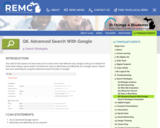
Spend less time searching by using the advanced search function in Google!
- Subject:
- Education
- Educational Technology
- Material Type:
- Activity/Lab
- Provider:
- REMC Association of Michigan
- Provider Set:
- 21 Things 4 Students
- Date Added:
- 08/02/2021

Spend less time searching by using the advanced search function in Google!

Students build online searching skills and best sites for searching
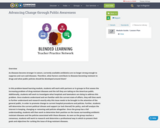
As diseases become stronger in nature, currently available antibiotics are no longer strong enough to suppress and cure said diseases. Therefore, what factors contribute to diseases becoming resistant to drugs and what public policies should be developed around them? In this problem-based learning module, students will work with partners or in groups to first assess the increasing problem of drug-resistant diseases and the toll they are taking on the American public. Additionally, students will work to investigate what hospitals and lawmakers are doing to address this problem. Once students understand and are familiar with the current state of affairs, they will then work to further understand and research exactly why this issue needs to be brought to the attention of the general public, in order to promote change to current hospital procedures and policies. Further, students will determine the current political climate and support (or lack thereof) for policy, and will analyze the interest in keeping, changing or removing said policies altogether. Once the group has a full understanding, students will then work to determine their position on the issues surrounding antibiotic resistant diseases and the policies associated with these diseases. As soon as the group reaches a consensus, students will work to research and determine a professional way in which to present their goals and objectives for curbing the issue of drug-resistant diseases.
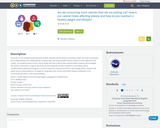
In this problem-based learning module, students will be asked to brainstorm ideas and think innovatively both independently and collaboratively in addressing a real-world problem that is relevant to their daily lives and health. Are students aware of their calorie intake and how it affects their overall health? Students will investigate the calories consumed in a typical day and how much physical activity is needed to stay healthy and fit. Students/teams will be encouraged to use the internet for research purposes in their design phase. Students will utilize various online platforms to design an infographic that can be shared with relevant individuals in the community and others in the school building

Any cause worth fighting for will usually come at a cost. In the fight to gain independence from England, many patriots lost their lives. In this comparison of some battles fought in the Revolutionary War, learn how the outcomes affected the quest for independence.
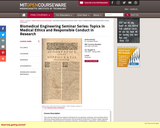
Seminars exploring current research and topical issues in the biomedical sciences, addressed at the general theme of innovation. Seminars are organized in blocks with related content, and are presented by prominent outside speakers as well as by HST faculty members and graduate students. Each seminar block includes several semi-weekly presentations, in addition to wide-ranging discussions among speakers, faculty, and students. Discussions involve issues such as relations between presented research areas, requirements for further advances in the "state of the art", the role of enabling technologies, the responsible practice of biomedical research, and career paths in the biomedical sciences.

Students will write birthday wishes on a Jamboard to students. They will use the sticky note to write down a birthday wish for that student. Then, the teacher can print it out for the birthday student and email it to them personally.

In the EL Education model, teachers engage students in meaningful and productive work throughout the class period. When delivering lessons, teachers create purpose and build curiosity for students. They use classroom management techniques that promote equity and create a respectful, active, collaborative, and growth-oriented culture. They make time to confer with students and are aware of each student’s level of understanding and participation. Teachers use practices that ensure all students grapple with challenging content. Teachers foster character by building positive relationships with students and inspiring each student to develop craftsmanship, perseverance, collaborative skills, and responsibility for learning. They promote critical thinking by asking that students make connections, perceive patterns and relationships, understand diverse perspectives, supply evidence for inferences and conclusions, and generalize to the big ideas of the discipline studied.
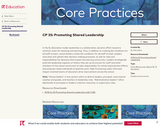
In the EL Education model, leadership is a collaborative, dynamic effort toward a common vision for teaching and learning. Thus, in addition to creating the conditions for all staff to learn, school leaders create the conditions for all staff to lead. Leaders articulate and uphold clear decision-making processes, as well as roles and responsibilities for decisions that impact the learning community. Leaders strategically build the leadership capacity of others; they set up structures for staff and other members of the school community to take responsibility for school improvement efforts and empower these individuals to lead the work. High-functioning, data-informed, impact-oriented teams of educators drive improvement across the school.
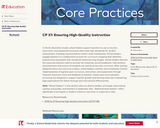
In the EL Education model, school leaders support teachers to use curriculum, instruction, and assessment practices that meet high standards for student achievement, including required district and/or state frameworks. School leaders engage teachers in a collaborative process for curriculum mapping that identifies assessments associated with standards-based learning targets. School leaders allocate the resources teachers need to provide the materials, accommodations, interventions, and extensions that ensure all students can and do access the curriculum. After putting adequate plans and resources in place, school leaders carefully and consistently monitor implementation of agreed-upon curriculum, instruction, and assessment through frequent classroom visits and feedback to teachers. Supervision and evaluation structures are designed to support teacher growth and learning while also maintaining high expectations for follow-through and instructional effectiveness.
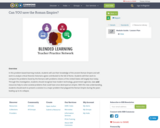
In this problem-based learning module, students will use their knowledge of the ancient Roman Empire and will work to analyze critical theories historians agree contributed to the fall of Rome. Students will then work to compare the problems faced by the Romans with problems citizens of the United States still largely face today. Through this investigation, students should recognize how modern technology, government agencies, laws and resources help to solve societal problems that could have once destroyed an empire. With this new understanding, students should work to present a solution to a major problem that plagued the Roman Empire during the years leading up to its collapse.
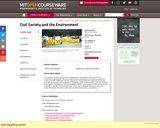
This graduate seminar examines the roles that civil society actors play in international, national, and local environmental governance. We will consider theories pertaining to civil society development, social movement mobilization, and relations between state and non-state actors. During the course of the semester, particular attention will be given to the legitimacy and accountability of nongovernmental organizations (NGOs). Case studies of civil society response to specific environmental issues will be used to illustrate theoretical issues and assess the impacts that these actors have on environmental policy and planning.
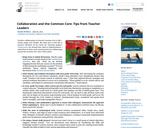
Teachers collaborating to bring the Common Core to life—sounds simple and sensible. But what does it look like in practice? Members of the Center for Teaching Quality’s Collaboratory are already knee-deep in implementation. This brief article summarizes their advice for some starting points for collaborating around the Common Core.
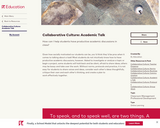
Given how socially motivated our students can be, you'd think they'd be pros when it comes to talking about a task! Most students do not intuitively know how to have productive academic discussions, however. Asked to investigate or analyze a topic or begin a project, some students will hold back and be silent, afraid to share ideas; others may be bossy and take over the work. Without norms, protocols and practice, it is not easy for students to share voices and ideas, consider each other’s ideas thoughtfully, critique their own and each other’s thinking, and create a plan to work effectively together.

A teacher addresses students in the classroom: "I notice Marcel, Quentin and Marielle got right to work. I see Trevor helping Sienna find a pen--thanks for helping her out, Trevor. Kayla, where can you look or whom can you ask if you're not sure what you should be working on right now?" The teacher's noticing and reinforcement of the positive behaviors she wants to see gives other students a chance to take responsibility for doing what they need to do. Communication, when building a collaborative classroom, is less about what the teachers say, and more about how they "listen to" and respond to what they see.
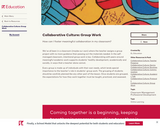
We've all been in a classroom (maybe our own) where the teacher assigns a group project with no more guidance than passing out the materials needed. In the self-managed classroom, intentional group work is key. Collaborating with peers around meaningful academic work supports students' healthy development, academically and socially, in ways that a teacher alone cannot.
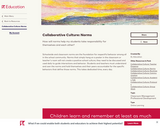
Schoolwide and classroom norms are the foundation for respectful behavior among all in the school community. Norms that simply hang on a poster in the classroom or teacher's room will not create a positive school culture; they need to be discussed and used daily to guide interactions and behavior. Students and teachers must understand and own the norms and hold themselves and their peers accountable for the specific behaviors that define those norms. This takes dedicated time, every day.

"Protocol" is the term we use for a related, well-defined set of actions in a classroom used for a specific academic purpose. Protocols are usually structured in a step-by-step procedure (as in, "First, find a partner. Then, take turns reading the provided paragraph aloud."), and can be used in multiple ways: a small sample of these uses includes sharing information, peer editing, or brainstorming; addressing complex social and academic challenges; sharing successes and points of view; heading off typical errors in learning; or introducing a new and engaging topic.
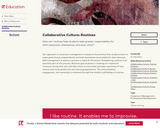
Our approach to classroom management is based on the premise that students learn to make good choices independently and hold themselves accountable for their behavior. Self-management is always a process in need of refinement. Establishing routines is an essential part of this process. Routines give students a roadmap for important moments during their day and allow them to internalize and take ownership of their choices and move quickly into new learning experiences. This internalization, engagement, and ownership is achieved through the mindful scaffolding of routines.
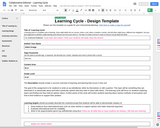
The goal of this assignment is for students to write an editorial, either by themselves or with a partner. This topic will be something they are interested in or passionate about and hold a particular opinion that they wish to share with others. The learning cycle will focus on students exploring topics and finding one they hold an opinion about. Further points of the cycle will involve students learning about various methods of persuasion and how to find evidence to support their position.